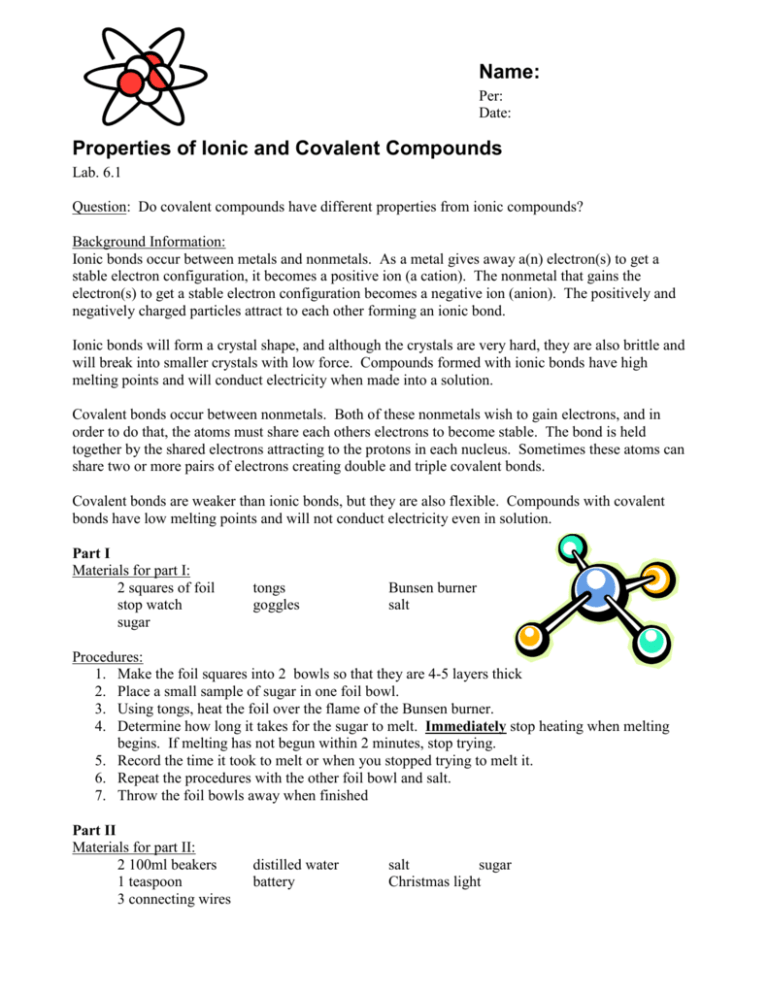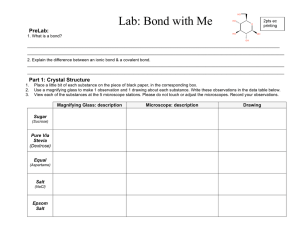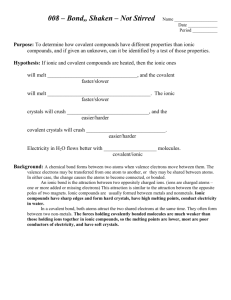Properties of Ionic and Covalent Compounds
advertisement

Name: Per: Date: Properties of Ionic and Covalent Compounds Lab. 6.1 Question: Do covalent compounds have different properties from ionic compounds? Background Information: Ionic bonds occur between metals and nonmetals. As a metal gives away a(n) electron(s) to get a stable electron configuration, it becomes a positive ion (a cation). The nonmetal that gains the electron(s) to get a stable electron configuration becomes a negative ion (anion). The positively and negatively charged particles attract to each other forming an ionic bond. Ionic bonds will form a crystal shape, and although the crystals are very hard, they are also brittle and will break into smaller crystals with low force. Compounds formed with ionic bonds have high melting points and will conduct electricity when made into a solution. Covalent bonds occur between nonmetals. Both of these nonmetals wish to gain electrons, and in order to do that, the atoms must share each others electrons to become stable. The bond is held together by the shared electrons attracting to the protons in each nucleus. Sometimes these atoms can share two or more pairs of electrons creating double and triple covalent bonds. Covalent bonds are weaker than ionic bonds, but they are also flexible. Compounds with covalent bonds have low melting points and will not conduct electricity even in solution. Part I Materials for part I: 2 squares of foil stop watch sugar tongs goggles Bunsen burner salt Procedures: 1. Make the foil squares into 2 bowls so that they are 4-5 layers thick 2. Place a small sample of sugar in one foil bowl. 3. Using tongs, heat the foil over the flame of the Bunsen burner. 4. Determine how long it takes for the sugar to melt. Immediately stop heating when melting begins. If melting has not begun within 2 minutes, stop trying. 5. Record the time it took to melt or when you stopped trying to melt it. 6. Repeat the procedures with the other foil bowl and salt. 7. Throw the foil bowls away when finished Part II Materials for part II: 2 100ml beakers 1 teaspoon 3 connecting wires distilled water battery salt sugar Christmas light Procedures: 1. Pour 50 mL of distilled water into a beaker. Add a teaspoon of salt and stir until the salt is dissolved. 2. Set up the circuit as shown in the drawing. If you are using a power source instead of a battery, only turn the power on ½ way or you will blow the bulb and get no results. 3. Observe the results when the circuit is connected and record your observations. 4. Repeat the procedures with sugar. 5. Wash both beakers with soap and water and turn them upside down on a paper towel to let dry. Christmas Light Wire 1 Wire 2 Battery Or Power Source Wire 3 Salt Water Or DATA: Sugar Part I Part II Substance Tested Does it melt? If yes, Conducts electricity? Water time to melt (sec) Salt Sugar Analysis and Conclusions: 1. Which substance has a higher melting point? How do you know? 2. According to the data, which substance appears to be an ionic compound? 3. Which substance appears to be a covalent compound? 4. Draw the electron dot model of a salt molecule: 5. What elements make up a sugar molecule? (think of how photosynthesis works; water + carbon dioxide + light energy makes sugar and oxygen – see page 282 for the equation). Are these elements in a sugar molecule metals, nonmetals, or a combination of metals and nonmetals? 6. In conclusion, compare and contrast ionic and covalent compounds. (use at least 5 characteristics)








